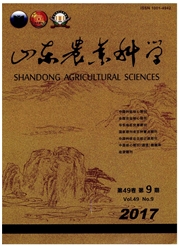

 中文摘要:
中文摘要:
温度诱导载脂蛋白(temperature induced lipocalin,TIL)在调控植物生长发育以及抗逆境胁迫方面具有重要作用。本研究利用生物信息学方法,从大白菜基因组中鉴定获得4个TILs基因(被命名为Br TILs),它们不均匀分布在大白菜2、3、10号染色体上。通过对其基因和蛋白特征的分析发现,Br TILs基因编码区序列长414-750 bp,预测编码蛋白氨基酸长度为137-249 aa,分子量15.71-28.41 k D,等电点4.90-9.25。通过多重序列比对发现,Br TILs基因不同成员的DNA序列存在高度的相似性,但不同成员的exon/intron结构存在较大差异。利用RT-q PCR技术对Br TILs基因的表达模式进行分析发现,不同成员在不同组织中的表达以及对温度胁迫的响应模式方面存在较大差异,这可能与它们的启动子区具有不同的顺式响应元件有关。在拟南芥中过量表达Br TIL2和Br TIL4基因发现,虽然它们的表达模式存在较大差异,但是二者在抗温度和盐胁迫中的功能相似。过量表达Br TIL2和Br TIL4基因都不能提高转基因植株对温度胁迫的基础抗性,但二者均可提高转基因植株对盐胁迫的抗性。本研究不仅为我们全面了解大白菜TILs基因功能奠定基础,也为大白菜抗逆分子育种提供了重要参考。
 英文摘要:
英文摘要:
The temperature induced lipocalin( TIL) protein plays an important role in the regulation of plant growth and development as well as the resistance to various stresses. In this study,four TIL genes were identified from the Chinese cabbage genome by bioinformatics method,and they were unevenly distributed on the Chinese cabbage chromosomes of A02,A03 and A10. Through the analysis of their gene and protein characteristics,it was found that the coding region of the four TIL genes were 414 - 750 bp,the predicted aminoacid length were 137 - 249 aa,the molecular weight were 15. 71 - 28. 41 k D,and the p I value were 4. 90 -9. 25. The multiple sequence alignment revealed that the DNA sequences of different Br TILs were highly similar,while their exon/intron structures were largely different. Furthermore,the expression pattern of Br TIL genes were analyzed using real-time quantitative PCR method( qRT-PCR). It was shown that different BrTILs had different expression patterns in different tissues of Chinese cabbage and the response patterns to temperature stress were also different,which might be related to different cis-elements in their promoter regions.The over-expression of Br TIL2 and Br TIL4 genes in Arabidopsis revealed that they both had similar functions in response to temperature and salt stress although their expression patterns had big differences. For example,over-expression of Br TIL2 and Br TIL4 genes could not improve the resistance to temperature stress,but could enhance the resistance to salt stress. This study not only provides a basis for the comprehensive understanding of the function of TIL genes in Chinese cabbage,but also provides important references for their applications in molecular breeding of Chinese cabbage.
 同期刊论文项目
同期刊论文项目
 同项目期刊论文
同项目期刊论文
 期刊信息
期刊信息
